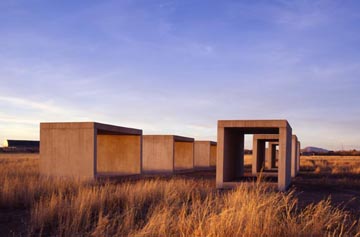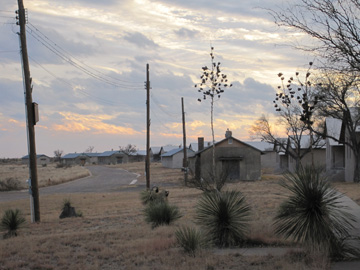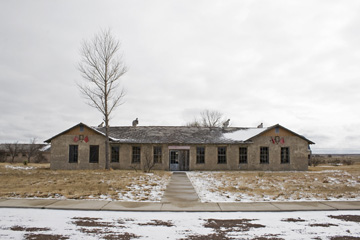
Donald Judd, "15 untitled works in concrete," 1980-1984
In a short essay dealing with the peculiarities of the West Texas that Donald Judd called home, he writes,
Here, everywhere, the destruction of new land is a brutality…Within a real view of the world and the universe this violence would be a sin – there are no words since there are no ethics that correspond to the present known nature of the world. I’ve never built anything on new land.[1]
While Judd confessed that the modification of existing structures proved to be a tiresome activity, his respect for utilitarian architecture and engineering, as well as his reverence for the landscape, trumped these frustrations throughout much of his time in Marfa.[2] Here at the Chinati Foundation, this sensitivity to the local environment, both built and natural, is particularly striking.
Judd’s interest in an authorless architecture born of necessity was first evinced in his 1963 essay, “Kansas City Report.” In this report from the field, Judd moves from an appraisal of the art housed in the Nelson Atkins Museum to consider the aesthetics of Kansas City’s edifices and environs. Structurally, in the “Kansas City Report,” Judd calls attention to the lack of connectivity between the art of the Midwestern grain elevator, mill, or silo, and the “art from five thousand miles away and usually centuries before” found in the Nelson Atkins.[3] Of the mill, Judd states, “it had a purpose, they wanted it a certain way; it was not imposed from the outside.”[4] It is this connectivity between existing buildings, local environment, and permanently installed art that Judd would achieve at Chinati.
The disposition of Judd’s approach to his architectural adaptations is a specific, responsive, and non-invasive one that has been characterized as a process of “tidying up.”[5] The barracks, mess halls, stables, gymnasium, tennis court, and artillery sheds of what was Fort D. A. Russell now comprise the exhibition, living, and working spaces of the Foundation. In shifting the buildings from one utility to another, Judd enhances, what he termed in a 1964 review, the “plain beauty of well-made things.”[6] Eschewing military-issue shingles for corrugated metal – the roofing material of choice in this region of Texas – and using adobe to modify windows and entryways were among the practical and aesthetic choices made by Judd during the renovations. He asserts, “Materials vary from place to place; local ones are cheap, are usually better suited to the climate and those doing the work know how to use them.”[7]

The Chinati Foundation, 2009
The use of proper (local) materials is perhaps best seen in the subtle metamorphosis of the two artillery sheds now housing Judd’s 100 hundred untitled works in mill aluminum. The changes made were few, but notable. The flat roofs of the two sheds proved unsound, so to address this difficulty, a corrugated, galvanized metal Quonset hut-style roof was added. This choice of roofing material was both aesthetic and practical. Judd writes, “In Valentine nearby, thirty miles, there was a large storage building, once curve from the ground to the ground, very deep and broad corrugations, obviously structure itself. Similar vaults were built as the roofs of the two artillery sheds.”[8] Taking a cue from local utilitarian forms of the Valentine storage facility, the hut-style roof doubled the sheds in height and gave the structures a less cumbersome appearance. Quartered aluminum windows replaced the garage doors, which better suited the works of art inside and fluidly brought into view the high desert landscape and Judd’s 15 untitled works in concrete outside. In a comprehensive article dealing with the execution of the works in concrete and aluminum, Marianne Stockebrand, director of Chinati, writes, “From this angle, everything connects—indoors and outdoors, aluminum and concrete, blocks and barrel shapes, transparency and closure, light and shade, nature and built spaces.”[9]
As Stockebrand suggests, Judd’s appreciation for the aesthetics of the region extended beyond his attraction to the structural repetition of a corrugated metal roof or the rough texture of adobe, to encompass the surrounding grasses, mountains, and sky. Contrary to most museum visits, an outing at Chinati is more of an all-day hike, moving in and out of installations while traversing the property. The vistas of the natural landscape are on equal footing with the art and architecture; each informs the other. In moving through Dan Flavin’s Untitled (Marfa Project), an installation that spans six U-shaped barracks, the interplay of the made and the natural is optically and spatially arresting. The colored artificial light projects its immaterial hues in the white-walled corridors and enters into an exchange with the harshly-angled winter sunlight pouring through the windows at the end of each passageway. The interchange of light sources warps and elongates one’s apprehension of the spatial parameters of the architectural enclosures. Viewing the landscape from within the aura of Flavin’s bulbs acutely inflects one’s perception of the contrast of grass to sky to distant peak—the grooves of the metal roofing, too, recall the repeated vertical forms of the fluorescent bulbs. Likewise, the angle and quality of the sunlight inform the experience of the fluorescent glow.

Ilya Kabakov, "School No. 6," 1993
A recent dusting of snow here in Marfa demonstrated just how responsive these installations are to their surroundings. The Icelandic rocks that comprise a work by Richard Long from 1988 located on the Fort’s former tennis court, some still cloaked in snow, seemed to emerge fresh from the slab of concrete. The varying states of dryness of the stones seemed to accentuate their pores and coloration. Ilya Kabakov’s School No. 6, an environmental installation that encompasses an old barracks, interior courtyard, and its surroundings, is meant to recall a derelict schoolhouse of the Soviet era. Looking out the windows, beyond the overturned furniture and childhood ephemera, the snow-covered yellow grasses furthered the desolate effect ordinarily imbued by the installation, as the West Texas landscape was momentarily equivalent to the Russian steppe. Likewise, the 100 aluminum works respond variously to exterior light and weather conditions. The additional reflective surface of the snow, despite the overcast skies, gave the boxes what appeared to be an interior radiance.
The experiences I describe are not and can never be authoritative and this is the specific intention of the Chinati Foundation. The permanence of the installations does not translate to a permanence of meaning. Rather, the production of meaning happens only through activity and can only be provisional and, most importantly, experiential. Recalling John Dewey’s understanding of art as experience, the localized Chinati experience cannot be bracketed off nor do its constituent parts sacrifice their self-identity. As Dewey writes: “every successive part flows freely without unfilled blanks into what ensues.”[10] A moment of coherence—where art, architecture, landscape, and activity all enliven one another—is the art of the Chinati Foundation.
Anna Kryczka is an intern at the Chinati Foundation. She earned her Master’s degree in Art History from the School of the Art Institute of Chicago in May 2009.
[1] Donald Judd, “Ayala de Chinati.” Architektur Munster: Westfalischer Kunstverein,1989: 60-61.
[2] Donald Judd, “Concrete Buildings.” Ibid., 88-89.
[3] Donald Judd, “Kansas City Report.” Complete Writings 1959-1975. Halifax and New York: The Press of the Nova Scotia College of Art and Design, New York University Press, 1976: 103.
[4] Ibid., 104
[5] “In all cases, the renovation mainly consisted in an ‘act of claiming’ to preserve the spaces, the buildings in their pure form.” (Stockebrand, Marianne Architektur Munster: Westfalischer Kunstverein, 1989: 9.)
[6] Donald Judd, “Month in Review,” October 1964. Complete Writings 1959-1975, 1976: 138. “None of the plain beauty of well-made things has ever gotten in to New York’s housing projects[.]” In this article, Judd bemoans most of what would be deemed proper architecture, asserting to the contrary, “dams, roads, bridges, tunnels, storage buildings, and various other useful structures comprise the best visible things made this century. “(137). See also Karen Stein, “The Plain Beauty of Well-Made Things” in The Writings of Donald Judd Marfa, The Chinati Foundation: 2009.
[7] Donald Judd, “Art and Architecture (1987).” Architektur Munster: Westfalischer Kunstverein,1989: 197. Further, in the 1965 essay, “Specific Objects,” Judd writes, “Materials vary greatly and are simply materials – formica, aluminum, cold-rolled steel, Plexiglas, red and common brass and so forth. They are specific” (187).
[8] Donald Judd, “Artillery Sheds.” Architektur Munster: Westfalischer Kunstverein, 1989: 74.
[9] Marianne Stockebrand, “The Making of Two Works: Donald Judd’s Installations at the Chinati Foundation.” Chinati Newsletter Vol. 4 (2004): 60.
[10] John Dewey, Art as Experience. New York: Pedigree Books, 1934: 37.




Pingback: What’s Cookin at the Art21 Blog: A Weekly Index | Art21 Blog